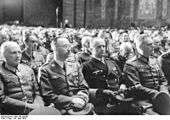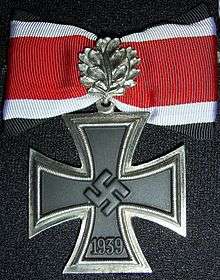Hans-Valentin Hube
| Hans Hube | |
|---|---|
 Generaloberst Hans-Valentin Hube | |
| Born |
29 October 1890 Naumburg an der Saale, German Empire |
| Died |
21 April 1944 (aged 53) Salzberg, Nazi Germany |
| Buried at | Invalidenfriedhof Berlin |
| Allegiance |
|
| Service/branch | Heer |
| Years of service | 1909–44 |
| Rank | Generaloberst |
| Commands held | 16th Infantry Division, XIV Panzer Corps, 1st Panzer Army |
| Battles/wars | |
| Awards | Knight's Cross of the Iron Cross with Oak Leaves, Swords and Diamonds |
Hans-Valentin Hube (29 October 1890 – 21 April 1944) was a German general during World War II.
Hube, a decorated World War I veteran and Generaloberst, commanded several panzer divisions of the Wehrmacht in Poland, France and the Soviet Union, for which he was one of 27 people to be awarded the Knight's Cross of the Iron Cross with Oak Leaves, Swords and Diamonds, Nazi Germany's highest military decoration.
On 21 April 1944, Hube died when his aircraft crashed near Salzberg.
World War II
Hans-Valentin Hube was born on 29 October, 1890, in Naumburg an der Saale, German Empire. Hube volunteered for military service in the Imperial German Army in 1909, and served during World War I where he saw action in the battle of the Race to the Sea, and was awarded the Iron Cross 2nd Class and the Knight's Cross of the House Order of Hohenzollern. In 1918, following the end of the war which ended with the German Empire's defeat and subsequent collapse, Hube briefly served with the right-wing Freikorps paramilitary during the instability. Hube joined the Reichswehr, the successor of the Imperial German Army after the establishment of the Weimar Republic, and continued his army service in the Wehrmacht after the founding of Nazi Germany, reaching the rank of Oberst in 1936.[1]

Hube took part in the invasion of Poland and the Battle of France as a regimental commander.[2] He was appointed commander of 16th Infantry Division in June 1940. As commander of the 16th Panzer Division, he took part in Operation Barbarossa as part of Marshal Gerd von Rundstedt's Army Group South. For this action during the campaign, Hube got the Knight's Cross of the Iron Cross. On 16 January 1942, he was awarded the Oak leaves to the Knight's Cross for his actions in the Battle of Kiev. Hube then led the division during Fall Blau and the Battle of Stalingrad. In September 1942, Hube was given command of XIV Panzer Corps, the parent formation of the 16th Panzer Division.
Hube commanded the XIVth Corps during the Soviet counter-offensive, Operation Uranus. He was promoted to Generalleutnant and received the Swords to the Knight's Cross with Oakleaves from Adolf Hitler personally on 21 December 1942. During his time at the Führer-Headquarters in Rastenburg, Hube argued strongly, but to no avail, for Hitler to allow 6th Army to attempt a breakout. Instead, Hitler promised a new relief attack beginning in the middle of Feb. Hube conveyed that plan to Paulus upon his return to the cauldron. However, Hube was then ordered to fly out again on 10 Jan. to "reorganize the supply of the 6th Army."[3]
After the destruction of the 6th Army, Hube was sent to the Mediterranean front. He created Gruppe Hube in Sicily, an army-sized formation whose task was to defend German positions on the island. With the advent of Operation Husky on 10 July, Hube commanded the overall German defence. On 17 July 1943 Hube was given command of all army and Flak troops on the island. Hube organised the evacuation to the Italian peninsula. He had prepared a strong defensive line, the 'Etna Line' around Messina, that would enable Germans to make a progressive retreat while evacuating large parts of his army to the mainland. Patton began his assault on the line at Troina, but it was a linchpin of the defense and stubbornly held. Despite three 'end run' amphibious landings the Germans managed to keep the bulk of their forces beyond reach of capture, and maintain their evacuation plans. Withdrawing a large number of troops from the threat of capture on Sicily represented a major success for the Axis. Hube was later involved in the battles defending positions at Salerno during the Allied Operation Avalanche.

Hube was moved back to Germany to take command of the Führer-Reserve OKH. On 23 October 1943, Hube was delegated as commander of the 200,000 man 1st Panzer Army, then serving with Army Group South under Field Marshal Erich von Manstein. In February 1944, Hube was officially confirmed as commander of the 1st Panzer Army. Shortly after, III. Panzerkorps, one of Hube's units, was required to assist German forces breaking out of the Korsun-Cherkassy Pocket. Soon after this, Hube's force was encirled in a pocket near Kamenets-Podolsky. Hube lead the breakout which lasted from 27 March 1944 until 15 April 1944.
On 20 April 1944, Hube returned to Germany where Adolf Hitler personally awarded him the Diamonds to the Knight's Cross and promoted him to Generaloberst for his actions in Sicily, Salerno and in the Kamenets-Podolsky pocket. Hube was killed when the aircraft that was transporting him to Berlin crashed after takeoff in Salzburg on 21 April 1944.
Hube was given a state funeral in Berlin on 26 April 1944. His coffin was laid out in the Reich Chancellery and the eulogy was delivered by Heinz Guderian. The guard of honour consisted of the generals Walther Nehring, Hermann Breith, Heinrich Eberbach and Hans Gollnick. Hube was buried at the Invalid's Cemetery in Berlin.[4]
Awards

- Iron Cross (1914) 2nd Class (1915) & 1st Class (1916)[5]
- Knight's Cross of the House Order of Hohenzollern with Swords (1918)[6]
- Clasp to the Iron Cross (1939) 2nd Class (24 May 1940) & 1st Class (3 June 1940)[5]
- Knight's Cross of the Iron Cross with Oak Leaves, Swords and Diamonds
- Knight's Cross on 1 August 1941 as Generalmajor and commander of the 16th Panzer Division[7]
- 62nd Oak Leaves on 16 January 1942 as Generalmajor and commander of the 16th Panzer Division[7]
- 22nd Swords on 21 December 1942 as Generalleutnant and commanding general of the XIV Panzer Corps[7]
- 13th Diamonds on 20 April 1944 as General der Panzertruppe and commander in chief of the 1st Panzer Army[7]
- Mentioned in the Wehrmachtbericht on 17 August 1943, 31 January 1944 and 9 April 1944
- Promoted to Generalleutnant on 1 January 1942; General der Panzertruppe on 1 October 1942; Generaloberst on 1 April 1944[8]
References
Citations
- ↑ Wegmann 2009, p. 360–363.
- ↑ Wegmann 2009, p. 361.
- ↑ Adam, Wilhelm; Ruhle, Otto (2015). With Paulus at Stalingrad. Translated by Tony Le Tissier. Pen and Sword Books Ltd. p. 161,166,170. ISBN 9781473833869.
- ↑ Stockert 2010, p. 59.
- 1 2 Thomas 1997, p. 309.
- ↑ Wegmann 2009, p. 362.
- 1 2 3 4 Scherzer 2007, p. 407.
- ↑ Wegmann 2009, p. 363.
Bibliography
- McCarthy, Peter; Syron, Mike (2002). Panzerkrieg: The Rise and Fall of Hitler's Tank Divisions. New York: Carol and Graf Publishers. ISBN 978-0-7867-1009-6.
- Scherzer, Veit (2007). Die Ritterkreuzträger 1939–1945 Die Inhaber des Ritterkreuzes des Eisernen Kreuzes 1939 von Heer, Luftwaffe, Kriegsmarine, Waffen-SS, Volkssturm sowie mit Deutschland verbündeter Streitkräfte nach den Unterlagen des Bundesarchives [The Knight's Cross Bearers 1939–1945 The Holders of the Knight's Cross of the Iron Cross 1939 by Army, Air Force, Navy, Waffen-SS, Volkssturm and Allied Forces with Germany According to the Documents of the Federal Archives] (in German). Jena, Germany: Scherzers Miltaer-Verlag. ISBN 978-3-938845-17-2.
- Stockert, Peter (2010). Die Brillantenträger der deutschen Wehrmacht 1941–1945—Zeitgeschichte in Farbe [The Diamonds Leaves Bearers of the German Armed Forces 1941–1945—History in Color] (in German). Selent, Germany: Pour le Mérite. ISBN 978-3-932381-59-1.
- Thomas, Franz (1997). Die Eichenlaubträger 1939–1945 Band 1: A–K [The Oak Leaves Bearers 1939–1945 Volume 1: A–K] (in German). Osnabrück, Germany: Biblio-Verlag. ISBN 978-3-7648-2299-6.
- Wegmann, Günter (2009). Die Ritterkreuzträger der Deutschen Wehrmacht 1939–1945 Teil VIIIa: Panzertruppe Band 2: F–H [The Knight's Cross Bearers of the German Wehrmacht 1939–1945 Part VIIIa: Panzer Force Volume 2: F–H] (in German). Bissendorf, Germany: Biblio-Verlag. ISBN 978-3-7648-2389-4.
Works
- Hube, Hans-Valentin (1925). Der Infanterist [The Infantryman] (in German). Charlottenburg, Germany: Offene Worte. OCLC 643823983.
- Hube, Hans-Valentin (1928). Schützendienst [Rifleman Service] (in German). Charlottenburg, Germany: Offene Worte. OCLC 833701714.
- Hube, Hans-Valentin (1935–1936). Der Infanterist Band 1—Für Kasernenstube und Unterrichtsraum [The Infantryman Volume 1—For Barracks and Classrooms] (in German). Berlin, Germany: Offene Worte. OCLC 248627859.
External links
- Hans-Valentin Hube in the German National Library catalogue
| Military offices | ||
|---|---|---|
| Preceded by Generalleutnant Heinrich Krampf |
Commander of 16. Infanterie-Division 1 June 1940 – 1 November 1940 |
Succeeded by General der Infanterie Friedrich-Wilhelm von Chappuis |
| Preceded by Generaloberst Eberhard von Mackensen |
Commander of 1. Panzerarmee 29 October 1943 – 21 April 1944 |
Succeeded by Generaloberst Erhard Raus |
